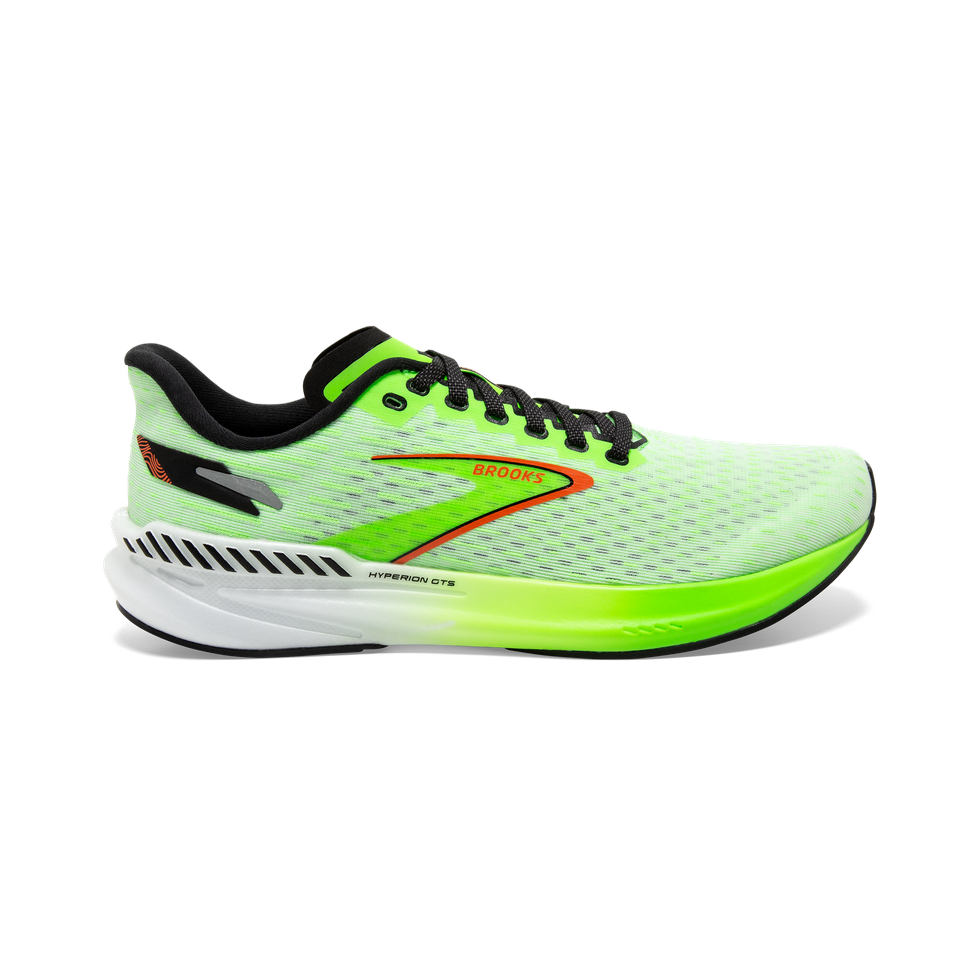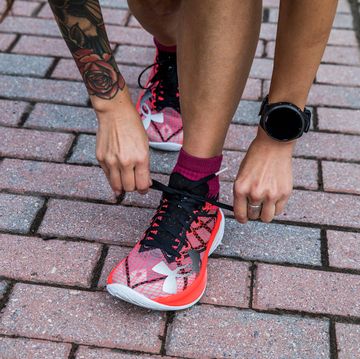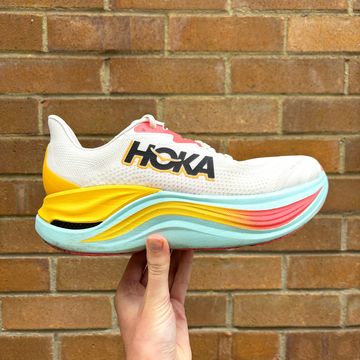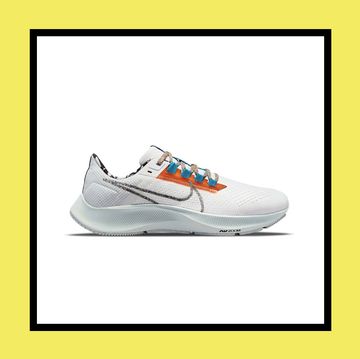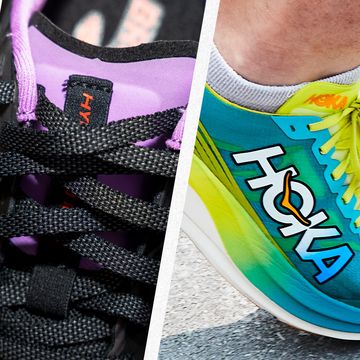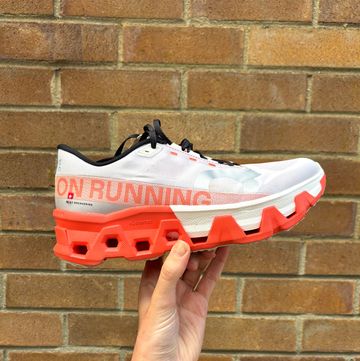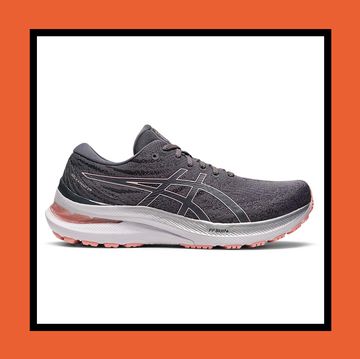The Runner's World test team have decades of experience trying out hundreds of running shoes, spanning every brand and every type you can think of (and probably a few you never realised existed). We endeavour to thoroughly road-test every shoe out there, putting in the miles in all kinds of conditions, poring over the specs and analysing how they translate to real-world experience. We then obsessively compare notes to review and rate each model, with only the very best earning a place on these pages.
These are our award winners – representing the various categories of the road-shoe spectrum to suit every type of runner and run, delivering to a standard we deem high enough to deserve our badge of approval and, more importantly, to be worthy of your hard-earned cash and precious miles. Read on to find your perfect sole-mate.
TYPE: Performance/Race
HEEL-TOE DROP: 8mm
Saucony has change the midsole mix in the latest Pro, adding a layer of Pwrrun HG to Pwrrun PB. The result is the v4 feels super soft on step in and once you get moving, the foam blend combines with the plate and Speedroll midsole to launch you forwards.
The mesh upper is featherweight and super breathable, while the rubber outsole has switched to a lattice design that improves traction, adding to the confidence factor in all conditions.
TYPE: Neutral
HEEL-TOE DROP: 8mm
The latest Novablast further evolves the excellent blend of cushioning and zip from previous models and our testers were impressed with the out-of-the-box comfort and found the new breathable, woven upper wraps the foot securely.
A thick wad of FF Blast Plus Eco foam delivers a superbly snappy ride and the rocker profile helps create a noticeable momentum at toe-off.
These performance features combine to make the Novablast 4 a very capable shoe for faster sessions, along with the long runs and easy miles you know are in its wheelhouse, delivering a really versatile performer.
TYPE: Performance/Race
HEEL-TOE DROP: 8mm
For version 3 of the Alphafly, Nike wanted to improve comfort and stability so it cut away is gone and a continuous outsole has been added for stability. The new midsole improves arch comfort and reduces rubbing. A moulded sockliner supports the lower profile arch, while Flyknit heel pods offer additional padding. A focus on durability also acknowledges that runners need their £285 shoes to last.
Our testers loved the ride this shoe when at speed. It feels slightly more aggressive than the Alphafly 2, with more of a ‘tippy’ sensation – but also more smooth, stable, ‘dialled-in’ and connected. (Although it hasn’t lost that distinctive ‘clip-clop’ sound.)
Overall, the Alphafly 3 is punchy, light and more accommodating. Its bouncy, propulsive ride is an absolute joy, lockdown is near-perfect and the extra comfort is ideal for half marathon and marathon PB-chasers.
TYPE: Performance/Race
HEEL-TOE DROP: 8mm
The latest iteration of the Hyperion Elite is Brooks’ fastest shoe yet and a significant advance on the v3. It’s 8.5g lighter, which was noted and appreciated by testers who also enjoyed the new breathable, stretch woven upper – a ‘barely there’ almost waxy material that helps it to feel more like a super shoe. Under the bonnet the new DNA Flash v2 supercritical nitrogen-infused foam which, according to Brooks, delivers nearly 10% more energy return than the original DNA Flash used in the Elite 3, feels bouncy, supportive and plush. The carbon plate also gets a redesign: this is Brooks' first shoe to feature a full-length SpeedVault Race+ plate, which is another tangible upgrade on the Elite 3.Our testers found the toe-off wasn’t quite as snappy or aggressive as other carbon racers, but it did feel better than other super shoes when cornering and offered good traction, even on wet pavements. Overall, this isn’t the fastest, most propulsive (or most outlandish looking) carbon shoe out there, but its quick-but-comfortable ride makes it a great choice for runners in search of a safer, sturdier super shoe for races or fast sessions.
TYPE: Neutral/Max-cushioned
HEEL-TOE DROP: 8mm
The highly-cushioned staple is one of Asics’ best-selling and longest-running models, so the radical re-design of the v25 last year was a surprise. It worked well though, and v25 fans can breathe easy as there’s no such full-scale reinvention this time. A new engineered knit upper, along with tweaked eyelet construction gives a slightly more supportive midfoot hold. Upgraded outsole rubber improves both durability and grip – noticed and appreciated by a tester in ultramarathon training through the wet UK winter, but the most significant change is in the ride. With the stack height (42mm heel, 34mm forefoot) remaining the same, our testers expected little change to the underfoot feel, but found the 26 delivers a slightly firmer ride. There’s still a lot of cushion, but as seems to be a trend across all shoes this year, the Nimbus has become slightly more of an all-rounder, with one tester noting it now feels like something that would suit a long run with some tempo effort mixed in. The switch to Asics new Eco formula midsole foam may explain the firmer feel, and as some found the v25 a little too soft underfoot, the v26 may appeal to more runners.
TYPE: Neutral
HEEL-TOE DROP: 10mm
Adi’s play for a comfortable, consistent do-it-all daily trainer uses the brand new Dreamstrike+ foam. It’s similar to the Lightstrike Pro used in the adizero range, but less about out-and-out propulsion and more about comfort. In fact, comfort is king here; the step-in feel is plush, the heel counter cushioned and reassuring and the familiarity of the engineered mesh upper and tongue wrap the foot nicely and feel both secure and soft.The ride isn’t overly soft nor too hard, with a nicely balanced sensation of cushioning and responsiveness that offers feedback and ground-feel while keeping things smooth and supple. Long, easy miles tick by and faster tempo work feels very manageable. It can even handle some out-and-out sprints, though the lofty midsole stack makes cornering at speed mildly precarious.The heel lip has a pronounced bevel to aid heel strikers through initial impact and onto the midfoot. None of our testers are natural heel strikers, but it certainly worked when fatigue set in and form gets a little sloppy. A jack of all trades, the Supernova Rise will likely satisfy all running needs for those looking for something they can throw on whatever the session.
TYPE: Performance/Race
HEEL-TOE DROP: 8mm
Aside from the general ‘wow factor’, the first thing you notice about the Fast-R 2 is the midsole is split into two sections. Both use Puma’s excellent new Nitrofoam Elite super-foam but that midsole ‘gap’ can create a slightly unstable feeling at slower paces. In fairness, the Fast-R 2 isn’t designed for easy running and when you push the pace, it comes alive. The gap is no longer noticeable, heel-toe transition feels seamless and the super responsive foam creates a springiness and propulsion you feel will power PBs.The extended carbon plate, which pokes out the end of the shoe, puts more emphasis on your ankles and calves – something to consider if you have a history of injury in those areas. Our testers felt this also makes the Type-R a better bet for distances of half-marathon or less but it delivers in spades on shorter, sharper efforts).Weight is something of an issue for a super shoe, with competitors’ like the Vaporfly coming in significantly lighter, and the rear ‘shark’s fin’ seems to add little. But for runners with a powerful stride, deep pockets and possibly a desire to get noticed, the Fast-R 2 has much to recommend it.
TYPE: Neutral/Max cushioned
HEEL-TOE DROP: 6mm
The name may suggest simply a maxed-out version of Brooks’ popular Ghost model, but this is ultimately a very different shoe, which manages to offer the same high level of comfort paired with a much more responsive feel. The Max uses the same DNA Loft V2 midsole foam as the Ghost 15 and it works well used in greater volume (the Max has front/rear stack heights of 39mm/33mm, compared to the Ghost 15’s 35mm/23mm). An entirely new last, featuring a GlideRoll Rocker, helps promote smoother heel-toe transitions and our testers enjoyed the extra ‘pop’.A supportive heel counter delivers a locked-in feel and a touch more stability at the rear. This all makes sense with the increased stack height and translates to a reassuringly stable feeling shoe. There's a moderately plush tongue and the engineered mesh upper feels roomy, breathable and comfy.All in all the Max is a great option for runners looking for something with plenty of cushioning that’s also reasonably versatile. It hasn't quite got the snappiness of something like the Asics Novablast 4, but the new rocker profile is a welcome addition and helps to spur on tired legs.
TYPE: Performance/Race
HEEL-TOE DROP: 6mm
Takumi fans can rest easy that the updates stay true to the spirit of the cult favourite. If you’re new to the Takumi, you may be converted. This is an impressive racer that will suit most runners for anything from track work to 10K. Those used to racing in thinner shoes could tackle half marathons (and if you’re Emile Caress, the marathon). Though the 10 retains its relatively stripped back, low-profile silhouette, it weighs in a few grams heavier than the 9, but that’s not noticeable on the run. A new dual density weave upper is more forgiving than version 9, and a widened space between the heel pads reduces risk of Achilles aggravation. The major upgrade is the use of adidas’ glass fibre infused ENERGYRODS 2.0 in a single heel-to-toe structure which delivers a punchy, uniform feel. Two layers of Lightstrike Pro foam around the rods provide cushioning and excellent energy return without compromising that sense of connection with the ground that’s lost with some max-stacked super shoes. They also feel great cornering at speed and though obviously a long leap technological leap from traditional racing flats, the Takumi 10s evoke some of their best qualities, combined with modern super shoe features.
TYPE: Stability
HEEL-TOE DROP: 5mm
Overpronators searching for support, look this way. Mirroring its predecessor, the Arahi 7 features Hoka’s stable compression-moulded EVA midsole foam and signature J-frame midsole support to combat overpronation. It’s essentially, a firmer section of foam in the midfoot, which hooks around the back of the shoe in the shape of a J, from the medial to the lateral side. On the run, these elements combine to deliver supreme gait control, but it comes at the cost of a fairly firm and rigid ride. One tester commented that the cushioning lacks the springiness found in some cushioned daily shoes, such as Asics’ Novablast 4, and some may find it a little unforgiving. But then, that really is the point of a shoe like the Arahi 7 – to deliver a secure, assured, stable ride. Up top, the latest Arahi features a new zonally engineered flat-knit upper, which is more breathable, a plusher tongue and dual gusset beneath the lace line. These tweaks bring improved step-in comfort, a supportive if not slightly snug fit (we’d recommend going up half a size) and excellent lockdown. Comfort and stability is where the Arahi 7 truly excels and if that’s at the top of your priority list, it may be your perfect match.
TYPE: Neutral
HEEL-TOE DROP: 0mm
With a rocker profile and a pretty hefty 33mm stack, the Via Olympus 2 is designed as an everyday trainer that promotes efficient toe-off and serves up enough cushion to ward off the aches and pains that trouble some when they go zero drop. This is largely thanks to a softer EGO Max midsole foam and plush footbed, which our testers found ‘cocooned’ their feet without smothering them, and did an excellent job of absorbing ground impact, even when heel striking. Outsole traction is excellent, while Altra’s signature wide toe box gives a lovely, roomy splay that adds to a ‘natural’ feel. This isn’t a shoe to really go up the gears in – it’s fairly heavy and the ride can feel a tad clumpy and sluggish at speed – so you’ll probably want something a bit more responsive and springy for intervals or racing. But on slower sessions, easy workouts and recovery runs the Via Olympus 2 delivers unparalleled zero drop comfort. That makes it a great entry point for those curious about taking their first steps in a zero drop shoe, and for committed ‘flat-footers’ seeking extra comfort it’s an excellent addition to the roster on longer easier efforts.
TYPE: Performance/Race
HEEL-TOE DROP: 4mm
Building on learnings and athlete feedback from previous iterations, New Balance aimed to make the new SC Elite a record-breaker. And the result looks and feels like a completely different shoe. The biggest advance is its new 100% PEBA foam which, according to NB’s lab data, delivers 87% energy return compared with 83% in the v3. Our testers found it felt instantly lighter, more responsive and bouncy than its predecessor. This is also thanks to an updated carbon fibre plate design, which increases forefoot stiffness. The v4 sticks with the same 4mm drop. That’s relatively low for a super shoe, but NB believe it works best with the curve of the carbon plate and allows for additional foam under the forefoot for toe off, maximising energy return.Up top, FantomFit (a heat bonded film) delivers a much thinner mesh package which offers vastly improved midfoot lockdown and more structure while not ‘overbuilding’ the shoe with too much emphasis on comfort. All this creates much more of a classic super shoe feel. It's not unstable, uncomfortable or overly-aggressive – it's still a pretty accommodating compared to something like the Adios Pro 3 – but as intended it's now very much a speedster for fast sessions and race day rather than an all-rounder for most of your runs.
TYPE: Neutral
HEEL-TOE DROP: 8mm
With the previous iteration of their staple daily workhorse, Saucony opted for an ‘if it ain’t broke, don’t fix it’ approach. The 17 sees a much bigger transformation. A new engineered mesh upper balances enough flex to feel pliable and unrestrained while also feeling supportive and locking you in. A stretchy, gusseted tongue offers just the right amount of padding and there’s added comfort around the heel, but the biggest change is in the midsole. There’s no difference in overall stack height but upgrading to Pwrrun+ foam brings a marked improvement in the ride, which feels bouncier and softer than the Ride 16 and finds the sweet spot between offering enough cushioning for easy runs and enough liveliness for some faster running. Saucony has also added a hint of rocker geometry to the forefoot, which aids midfoot to forefoot transitions. All that makes the 17 a pretty versatile shoe – a little clunky for anything too speedy due to its wide, stable base perhaps, but more than capable if you’re looking to add some marathon pace tempo into your long run. The Ride has always been a good, mid-range daily trainer, but the latest evolution’s improved ride and versatility make it a fantastic pick for beginners and experienced runners alike.
TYPE: Neutral/Max cushioned
HEEL-TOE DROP: 8mm
According to Under Armour their new HOVR+ foam, which is packed into the 40mm/32mm heel/forefoot stack here, offers superior energy return and a springy feel. The ride certainly feels smooth, with that big stack absorbing everything, but the cushioning feels nicely tuned – energy return is good for a non-carbon shoe, with just enough responsiveness to stop it feeling overly mushy. Despite the high heel height it feels pretty stable on corners and uneven ground, thanks to a wider midsole shape, particularly around the heel, which is designed to balance the height and improve lateral stability. It also feels lighter than the weight suggests, perhaps due to the foam’s spring and the midsole profile which, with its curved toespring and bevelled heel, encourages a smooth roll-through during footstrike. The knitted upper uses different textures of weave in different areas, perforated above the toe box for breathability and reinforced at the sides for durability. Ridges link midsole and laces to create a secure, locked-in feel, aided by an elasticated internal sleeve; while the padded ankle collar and tongue add to an impressively plush step-in feel. A great everyday trainer option perfectly suited to making miles feel effortless on long, easy and recovery runs.
TYPE: Neutral/Max-cushioned
HEEL-TOE DROP: 6mm
With On’s thickest midsole (37mm heel; 31mm forefoot) packing its Helion super-foam, the Cloudeclipse is designed to ‘take comfort levels to new heights’. An interesting claim as On’s cushioned shoes tend to ride firmer than other brands’ plush offerings. The midsole also packs a double layer of On’s signature CloudTec (hollow pods which collapse and compress on impact) which helps to create a soft landing and smooth feel, but you won’t find all-out ‘pillowy’ here. A flexible speedboard ‘shank’ adds stability (necessary when you've got such a thick wedge of cushioning) but also injects an element of stiffness which helps a poppy toe-off. The overall ride is firmer and more responsive than other max-cushioned shoes and while the energy return isn't enough that you'd choose it for tempo or harder efforts, that added zip will appeal to some for longer efforts.Up top, the 100% recycled polyester mesh upper is lovely and breathable, the toebox roomy, a structured heel counter aids lockdown and our testers had no hotspot or blistering issues. The Cloudeclipse isn’t the lightest, but it isn't a shoe that really demands marginal weight savings and ultimately finds an interesting middle ground between cushioning and firmness to deliver a balanced, forgiving-yet-fun ride on longer, easier runs.
TYPE: Neutral/performance
HEEL-TOE DROP: 8mm
The Speed 4 is intended to fit into Saucony’s Endorphin line up as a training companion to the race-day Pro 4 (see pXX) or even more speed-focussed Elite models. It fulfils that role with aplomb, but it’s a little more aggressive than the Speed v3, which makes it something most would also happily turn to for their fastest sessions and chasing PBs. The midsole combines full-length PWRRUN PB PEBA foam with a nylon winged plate to serve up that bouncy PEBA feel, but it doesn’t ride as harsh or aggressive as all-out racing super shoes. Transition is beautifully smooth through the mid- and forefoot, with updated geometry making it feel a touch more stable. The upper is light and extremely breathable, fitting fairly snug for good lock-down. There’s a surprising dash of plushness from the rather thin looking tongue and an almost bucket shaped heel adds comfort, stability and hold. The same grippy lattice outsole as the Endorphin Pro 4 offers great traction, too. It all adds up to a really versatile shoe which easily shifts between paces. A perfect partner on multi-paced sessions and for those not in a rush to invest in an additional race shoe, it’ll serve you well on your big day over a wide range of distances.
TYPE: Performance/Race
HEEL-TOE DROP: 7mm
When we received Hoka’s new flagship racer for testing, we couldn’t resist drawing comparisons to other super shoes. Its decoupled heel, for instance, resembles the one found on the first two versions of the Nike Alphafly. And once we put shoe on, there was an instant familiarity to Hoka’s Rocket X and Rocket X2. Both the Cielo and Rocket models have accommodating fits, paired with that distinct Hoka cushioned feel. But their rides are a very different story.The Rocket X 2 is built around the full gait cycle — its rockered sole smooths heel-to-toe transitions for midfoot and forefoot strikers alike, but the Cielo sculpts an even more aggressive forefoot rocker to amp up speed and create an explosive ride. The midsole couples high-grade energy-returning PEBA foam with Hoka’s most advanced carbon-fibre plate (which uses a new winged design). Our testers immediately noticed the propulsive effects, with a rocking horse sensation just trying to stand still. At slower paces, the sole shape felt a bit awkward, but at speed (around 7:00 min/mile) the kick really intensifies. A great option for runners who want a highly propulsive super shoe with an aggressive rocker, but also need a wide, stable platform.
TYPE: Stability
HEEL-TOE DROP: 8mm
All Brooks’ GTS (go-to support) shoes use a GuideRails system – a holistic approach to promote foot and knee alignment. Denser foam on the lateral and medial sides of the midsole serves as a ‘bumper.’ GuideRails add a little extra weight, but this didn’t give the Hyperion GTS any black marks from our wear-testers who still found it very lightweight for the support it offers and enjoyed its responsiveness. Using the nitrogen-infused midsole foam developed for Brooks’ super shoes, the Hyperion GTS caters to speed demons who need just a little extra support and it hits the mark: one tester described it as having a similar feel to a racing flat, but the overpronator also praised the shoe’s stability during long runs. Other feedback noted the smooth heel-toe transitions and, interestingly, the stability features felt subtle enough that the shoe could accommodate neutral runners as well as overpronators. The only gripes were around the rather thin padding on tongue and collar, but that’s minor in a shoe that manages to so adeptly balance speed and support.


















